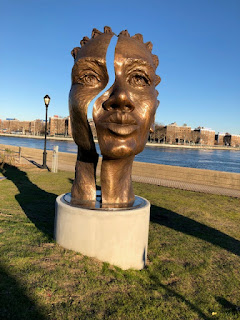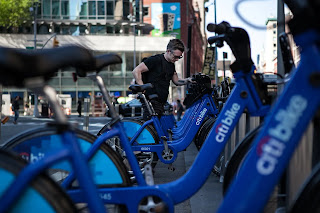I ride the bike lane on Crescent Street in Astoria only because it passes directly in front of my apartment--and I use it only to get home or to a street that will take me wherever I'm going.
In that sense, the Crescent Street lane is actually better than some: It not only takes me to my apartment; it also provides a direct connection between two major bridges with bike lanes: the Triborough/RFK and Queensborough/59th Street.
For a while, I was crossing the Triborough almost every day to work, and often use it for rides to points north, including Connecticut. But I take the Queensborough/59th Street only if I'm going to someplace within a few blocks of the Manhattan side. If I'm going to Midtown or downtown Manhattan, I prefer to pedal into Brooklyn and cross the Williamsburg or Manhattan Bridges.
The reason I like those bridges better is that the bike lanes are relatively wide and accessible. The Queensborough/59th Street Bridge, on the other hand, is--like the Crescent Street lane--narrow. How narrow? Well, I've come within a chain link width of brushing, or being brushed by, cyclists traveling in the opposite direction.
That problem has been exacerbated by motorized bikes and scooters. I was under the impression that they're supposed to be limited to a maximum speed of 40 kph (about 25 mph). But I've seen more than a few that were traveling well above that speed. And I have seen many more of them than cyclists run red lights, make careless turns and sideswipe cyclists and pedestrians.
 |
| Photo by Scott Gries--Getty Images |
I know I'm not the only one who's noticed. Christopher Ketcham said as much yesterday, in a New York Daily News guest editorial. He also points out something I've mentioned: It's illegal to operate those motorized vehicles in bike lanes. People do it; they endanger others; cops see it and do nothing.
Ketcham described such a scenario of which he had to be a part. Someone riding a motorized bike nearly knocked him off his bike on the Manhattan Bridge Lane. When he stopped to complain to the cops sitting on the complain to two cops stationed on the Manhattan side, one of them said, "We're here for the bikes."
So that officer admitted what many of us know: the police come after us because we're easy prey--and because, as former Transportation Alternatives head Charlie Komanoff said, "Cycling is everything cops are acculturated to despise: urban, improvisatory and joyous rather than suburban, rulebook and buttoned-up." I have noticed the hostility he and Ketcham describe even in cops who patrol on bicycles: I suspect that none of them ride when they're off the clock.
Some might say that Ketcham, Komanoff and I are paranoid or "not seeing the whole picture." Well, if we can't see from the proverbial 30,000 feet, we certainly can look through the wide-angle lens of statistics: In 2019, the NYPD handed cyclists 35,000 tickets for all sorts of infractions, from not having bells (more about that in a moment) to running red lights (even when, as I have described, crossing at the red light is safer for the cyclist and drivers). Truck drivers received 400 fewer tickets, although there are ten times as many trucks as bicycles on New York City streets.
When Ketcham complained to the cops at the foot of the Manhattan Bridge, they gave him a $98 ticket--for not having a bell and, allegedly, for yelling at the officers, according to the "Description/Narrative" portion of the ticket.
I wonder how many folks driving motorized bikes were ticketed for riding illegally in bike lanes (or on sidewalks), sideswiping cyclists and pedestrians--or yelling at police officers.



























